by Sheila Dunning | Jun 28, 2018
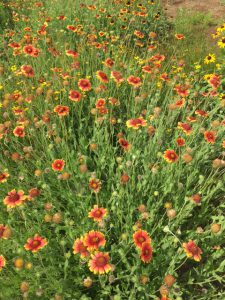 National Pollinator Week is only recognized in June, but efforts to encourage pollinators shouldn’t end then.
National Pollinator Week is only recognized in June, but efforts to encourage pollinators shouldn’t end then.
Pollination occurs when pollen grains are moved between two flowers of the same species, or within a single flower, by wind or animals that are pollinators. Successful pollination, which may require visits by multiple pollinators to a single flower, results in healthy fruit and fertile seeds, allowing plants to reproduce. Without pollinators, we simply wouldn’t have many crops!
Worldwide, approximately 1,000 plants grown for food, beverages, fibers, spices, and medicines need to be pollinated by animals in order to produce the goods on which we depend. Foods and beverages produced with the help of pollinators include blueberries, chocolate, coffee, melons, peaches, pumpkins, vanilla, and almonds.
About 75% of all flowering plants rely on animal pollinators and over 200,000 species of animals act as pollinators. Of those, about 1,000 are hummingbirds, bats, and small mammals. The rest are insects such as beetles, bees, ants, wasps, butterflies, and moths. Western honey bees are the most common.
Most species of bees don’t sting. Although all female bees are physically capable of stinging, most bee species native to the U.S. are “solitary bees,” that is, not living in colonies and don’t sting unless they are physically threatened or injured. Only honey bees are defensive and may chase someone who disturbs their hive.
It is wise, though, to avoid disturbing any bee or insect nest.
What everyone can do for pollinators:
Watch for pollinators. Get connected with nature. Take a walk, experience the landscape and look for pollinators which are most active midday in sunny, planted areas.
Reduce your impact. Reduce or eliminate your pesticide use, increase green spaces, and minimize impervious surfaces.
Plant for pollinators. Create pollinator-friendly habitat with native flowering plants that supply pollinators with nectar, pollen, and homes. For a list of plant choices go to: http://gardeningsolutions.ifas.ufl.edu/design/gardening-with-wildlife/bee-plants.html
What you can do to create a pollinator-friendly habitat:
Design your garden so that there is a continuous succession of plants flowering from spring through fall. Check for the species or cultivars best suited to your area.
Plant native to your region using plants that provide nectar for adults plus food for insect larvae, such as milkweed for monarchs. If you do use non-native plants, choose ones that don’t spread easily, since these could become invasive.
Select old-fashioned varieties of flowers whenever possible because breeding has caused some modern blooms to lose their fragrance and/or the nectar/pollen needed to attract and feed pollinators.
Install ‘houses’ for bats and native bees. For examples go to: http://edis.ifas.ufl.edu/uw290 or http://gardeningsolutions.ifas.ufl.edu/design/gardening-with-wildlife/pollinator-hotels.html
Avoid pesticides, even so-called “natural” ones such as Bacillus thuringiensis (Bt). If you must use them, use the most selective and least toxic ones and apply them at night when most pollinators aren’t active.
Supply water for all wildlife. A dripping faucet or a suspended container with a pinhole in the bottom is sufficient for some insects. Other wildlife need a small dish of water.
Provide water for butterflies without letting it become a mosquito breeding area. Refill containers daily or bury a shallow plant saucer to its rim in a sunny area, fill it with coarse pine bark, sand or stones and fill to overflowing with water.
Fun facts:
A tiny fly (a “midge”) no bigger than a pinhead is responsible for the world’s supply of chocolate
One out of every three mouthfuls of food we eat is delivered to us by pollinators.
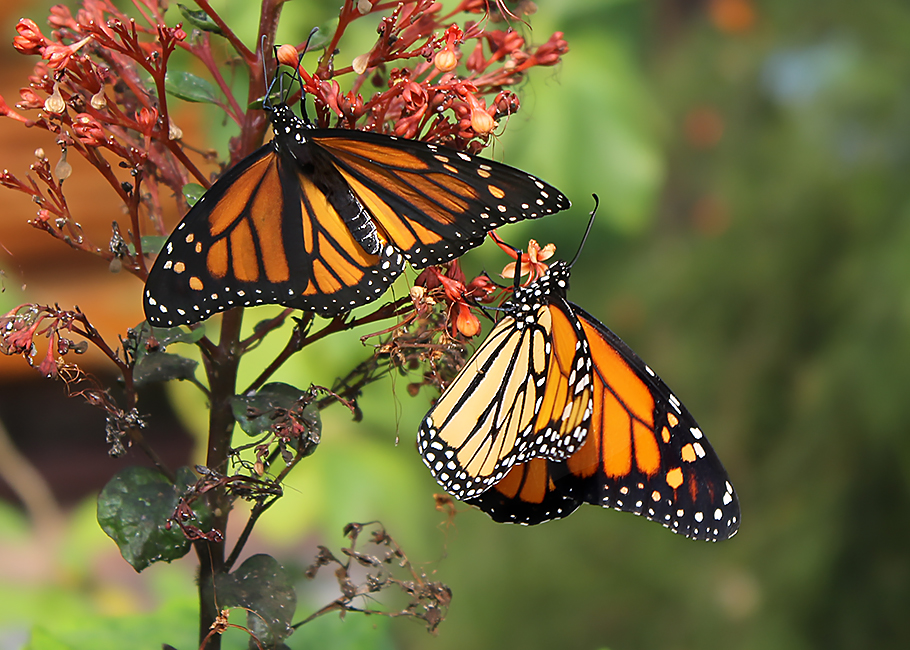
by Mary Salinas | Dec 14, 2017
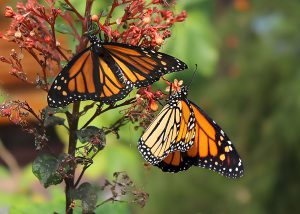
Monarch butterflies. Photo credit: Pia-Riitta Klein.
We have grown to love monarch butterflies, with their striking orange and black markings and their fascinating annual migration from southern Canada 3,000 miles south to Mexico. To help them, we have increasingly planted milkweed, the only plant on which their caterpillars will feed. In northwest Florida, the milkweed species most planted has been tropical milkweed, Asclepias curassavica, as it is lush, showy and easy to grow.
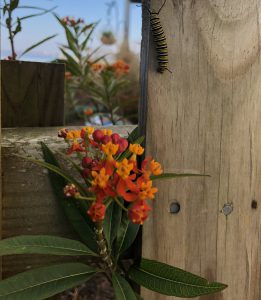
Tropical milkweed, Asclepias curassavica, was visited by this monarch caterpillar who is now off to find a suitable place to make his transformation into a chrysalis. Photo by Mary Salinas, UF/IFAS Extension.
Tropical milkweed, unlike our native milkweeds that die back in late fall, will continue to grow through the winter unless killed by a hard freeze. Even if the cold kills the stems, it may regrow quickly from the roots. This seems like an advantage, but maybe not. The availability of a host plant for the caterpillars may be prompting adult females to stay and lay eggs rather than migrate south and be protected from deadly freezes.
Experts are also exploring links between the longer persistence of the tropical milkweed into winter and a build-up on those plants of a serious parasite Ophryocystis elektroscirrha, commonly referred to as OE.
So, what is the answer?
- Cut back any tropical milkweed to the ground at Thanksgiving. That may encourage female monarchs to migrate and prevent a deadly build-up of OE spores on the plants.
- Consider adding some native milkweed species to your butterfly garden. Here are some recommended species from Dr. Jaret Daniels:
- Aquatic Milkweed (Asclepias perennis)
- Swamp Milkweed (Asclepias incarnata)
- Pinewoods Milkweed (Asclepias humistrata)
- Redring Milkweed (Asclepias variegata)
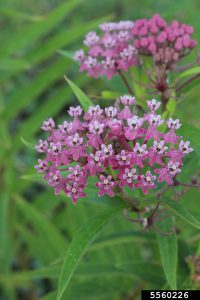
Swamp Milkweed, Asclepias incarnata. Photo credit: Chris Evans, University of Illinois.
For more information:
Are non-native milkweeds killing monarch butterflies?
Monarch Joint Venture: Potential risks of growing exotic (non-native) milkweeds for monarchs
Monarch Butterfly, Danaus plexippus Linnaeus (Lepidoptera: Nymphalidae: Danainae)
MonarchWatch.org
Gardening Solutions: Milkweed

by Molly Jameson | Nov 27, 2017
 If you are a regular reader of Gardening in the Panhandle, you know that this e-newsletter covers many topics related to ornamental and vegetable gardening, Florida-friendly landscaping, pest management, and lawn and garden fertility.
If you are a regular reader of Gardening in the Panhandle, you know that this e-newsletter covers many topics related to ornamental and vegetable gardening, Florida-friendly landscaping, pest management, and lawn and garden fertility.
But did you also know that UF/IFAS Extension in the Florida Panhandle has four other E-newsletters covering topics such as Florida agriculture, wildlife and natural resources, 4-H youth, economic well-being, health and nutrition, and overall life quality for individuals and families?
These other E-Extension in the Panhandle newsletters include Panhandle Agriculture , Panhandle Outdoors, 4-H in the Panhandle, and Living Well in the Panhandle.
[notice]Additionally, UF/IFAS also has an extensive collection of publications on many of these e-newsletter topics. If you haven’t already, check out the Extension Data Information Source (EDIS) website. It is a comprehensive, single-source repository of all current UF/IFAS numbered peer-reviewed publications. Visit EDIS for a complete listing.[/notice]
As a Gardening in the Panhandle enthusiast, here is a list of horticulture and gardening related EDIS publications you might find useful:
Vegetable Gardening
Home Lawns and Landscapes
Soil and Fertility
Pest Management
by Daniel J. Leonard | May 18, 2017
If you’re like me, growing turfgrass is often more of a hassle than anything else. Regardless of the species you plant, none tolerates shade well and it can seem like there is a never-ending list of chores and expenses that accompany lawn grass: mowing (at least one a week during the summer), fertilizing, and constantly battling weeds, disease and bugs. Wouldn’t it be nice if there were an acceptable alternative, at least for the parts of the lawn that get a little less foot traffic or are shady? Turns out there is! Enter the wonderful world of perennial groundcovers!
Perennial groundcovers are just that, plants that are either evergreen or herbaceous (killed to the ground by frost, similar to turfgrass) and are aggressive enough to cover the ground quickly. Once established, these solid masses of stylish, easy to grow plants serve many of the same functions traditional turf lawns do without all the hassle: choke out weeds, provide pleasing aesthetics, reduce erosion and runoff, and provide a habitat for beneficial insects and wildlife.
The two most common turfgrass replacements found in Northwest Florida are Ornamental Perennial Peanut (Arachis glabra) and Asiatic Jasmine (Trachelospermum asiaticum); though a native species of Mimosa (Mimosa strigillosa) is gaining popularity also. All of these plants are outstanding groundcovers but each fills a specific niche in the landscape.

Perennial Peanut Lawn
Perennial Peanut is a beautiful, aggressive groundcover that spreads through underground rhizomes and possesses showy yellow flowers throughout the year; the show stops only in the coldest winters when the plant is burned back to the ground by frost. It thrives in sunny, well-drained soils, needs no supplemental irrigation once established and because it is a legume, requires little to no supplemental fertilizer. It even thrives in coastal areas that are subject to periodic salt spray! If Perennial Peanut ever begins to look a little unkempt, a quick mowing at 3-4” will enhance its appearance.

Asiatic Jasmine
Asiatic Jasmine is a superb, vining groundcover option for areas that receive partial to full shade, though it will tolerate full sun. This evergreen plant sports glossy dark green foliage and is extremely aggressive (lending itself to very rapid establishment). Though not as vigorous a climber as its more well-known cousin Confederate Jasmine (Trachelospermum jasminoides), Asiatic Jasmine will eventually begin to slowly climb trees and other structures once it is fully established; this habit is easily controlled with infrequent pruning. Do not look for flowers on this vining groundcover however, as it does not initiate the bloom cycle unless allowed to climb.

Sunshine Mimosa
For those that prefer an all-native landscape, Sunshine Mimosa (Mimosa strigillosa), also known as Sensitive Plant, is a fantastic groundcover option for full-sun situations. This herbaceous perennial is very striking in flower, sending up bright pink, fiber-optic like blooms about 6” above the foliage all summer long! Sunshine Mimosa, like Perennial Peanut, is a legume so fertility needs are very low. It is also exceptionally drought tolerant and thrives in the deepest sands. If there is a dry problem spot in your lawn that receives full sun, you can’t go wrong with this one!
As a rule, the method of establishing groundcovers as turfgrass replacements takes a bit longer than with laying sod, which allows for an “instant” lawn. With groundcovers, sprigging containerized plants is most common as this is how the majority of these species are grown in production nurseries. This process involves planting the containerized sprigs on a grid in the planting area no more than 12” apart. The sprigs may be planted closer together (8”-10”) if more rapid establishment is desired.
During the establishment phase, weed control is critical to ensure proper development of the groundcover. The first step to reduce competitive weeds is to clean the site thoroughly before planting with a non-selective herbicide such as Glyphosate. After planting, grassy weeds may be treated with one of the selective herbicides Fusilade, Poast, Select, or Prism. Unfortunately, there are not any chemical treatments for broadleaf weed control in ornamental groundcovers but these can be managed by mowing or hand pulling and will eventually be choked out by the groundcover.
If you are tired of the turfgrass life and want some relief, try an ornamental groundcover instead! They are low-maintenance, cost effective, and very attractive! Happy gardening and as always, contact your local UF/IFAS County Extension Office for more information about this topic!
by Matt Lollar | May 18, 2017
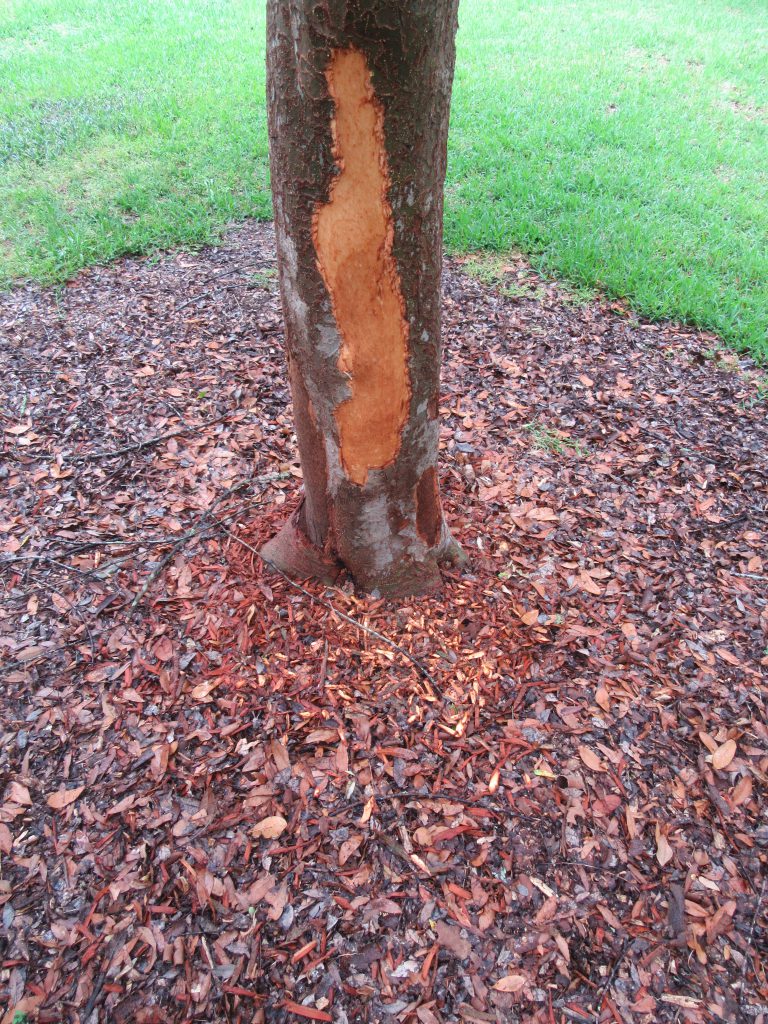
Squirrel bark stripping damage on a Chinese elm. Photo Credit: University of Florida/IFAS Extension
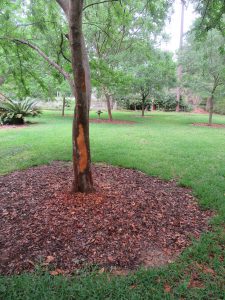
Barked stripped from the trunk of a Chinese elm. Photo Credit: University of Florida/IFAS Extension
The squirrels are at it again! This time they are stripping the bark from the trunks of my Chinese elm (Ulmus parvifolia) trees. Squirrels feed on the bark of a number of other different tree species including oaks, maples, and pecans. There are a few theories as to why squirrels feed on tree bark.
- Pregnant Females – Pregnant squirrels don’t eat prior to giving birth, but it is thought they chew on bark to help them bear the pain of pregnancy.
- Water Source – This theory isn’t very reputable due to the fact that squirrels have been seen feeding on bark come rain or shine.
- Food Source – The inner bark layer (phloem) contains sugar and nutrients which help satisfy a squirrel’s appetite.
The good news is squirrels generally do not eat enough bark to kill a tree. A squirrel will typically only strip a half inch section of bark about three inches long. However, the squirrels in my yard were much hungrier this year as you can see in the featured pictures.
Because squirrels do not usually girdle the trunk of the tree, they generally do not cause enough damage to kill a tree. However, their bark stripping habits can be unsightly in a well-maintained landscape. A few control options are available.
- Tree Wrap – Tree trunks can be wrapped with 24″ or longer aluminum flashing. Unfortunately, this option can be more unsightly than the bark stripped trunks.
- Repellents – A number of different wildlife repellents are on the market. Most repellents do not smell very good because they contain egg solids.
- Harvest – This is my favorite method of control! Make sure you follow all state and local laws.
For more information on wildlife management, please visit EDIS or The Internet Center for Wildlife Damage Management.
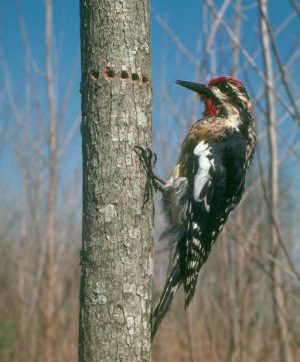
by Daniel J. Leonard | Feb 3, 2017
Have you noticed strange rings of pencil-sized holes on the trunks of certain trees in your landscape recently? If so, take heart that these holes are not emanating from an infestation of destructive insects but rather from a perfectly native, rather attractive migratory woodpecker, the Yellow-Bellied Sapsucker (Syphrapicus varius)!
The Sapsucker is a smallish bird with a chisel-like bill, easily distinguishable by bold black and white face stripes and a conspicuous bright-red crown and throat. If you have any problem identifying it by its features, look to its migration pattern, the Yellow-Bellied Sapsucker overwinters in mild winter areas of the Americas (like Florida’s Panhandle) and causes damage during this period (roughly December through March). If you notice a bird wreaking havoc on your backyard flora this afternoon, it is likely a Yellow-Bellied Sapsucker!
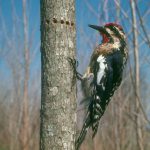
Yellow-bellied sapsucker (male) on pecan
James Solomon, USDA Forest Service, Bugwood.org
Like other members of its family, this woodpecker makes a living by “pecking” holes in trunks of trees and small shrubs about chest-high from the ground and feeds on sap and the occasional insect drawn to the sap. Fortunately, the damage is not usually harmful to the tree except in severe cases where the trunk may be girdled or secondary infection occurs from pests/diseases entering the tree through the holes. Unfortunately for Florida gardeners, this little bird has preferences in which trees it attacks, the majority of which are favorite landscape plants. For example, heavy feeding has been observed, both anecdotally by the author and more scientifically by researchers and birding enthusiasts, on Red Maple, Pecan, Chinese Elm, American Holly, Pine and Live Oak. They also really seem to enjoy any soft-wooded shrub limbed-up in a treelike form like Waxmyrtle, Viburnum and Dahoon Holly. Talk about frustrating!
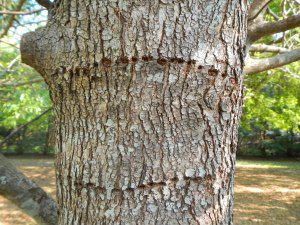
Sapsucker damage in a tree trunk.
Photo courtesy of Mississippi State Extension.
After learning that Sapsucker damage is not usually harmful, most homeowners opt to not control the birds’ feeding. However, if the aesthetic damage is not acceptable in your landscape, there are a few semi-effective control options and a host of other, less-effective home remedies. Wrapping the trunks of favored species with a loose, thick material such as burlap or felt is the preferred method of many ornamental nurseries and tree farms due to the material’s reusability and ease of removal after the migration has passed. Other commercial enterprises have had mixed success with hanging visually frightening CDs, pie plates and the like from low branches. Even less success has been seen with other homemade “cures” ranging from rubbing trunks of favored trees with Ivory soap to the use of sticky materials to deter perching. Shooting or trapping Yellow-Bellied Sapsuckers is not permitted as the birds are protected by state and federal wildlife law. As always, please contact your local UF / IFAS Extension office for advice and recommendations for other methods of discouraging unwanted bird visits!
Happy New Year and good gardening!
 National Pollinator Week is only recognized in June, but efforts to encourage pollinators shouldn’t end then.
National Pollinator Week is only recognized in June, but efforts to encourage pollinators shouldn’t end then.












